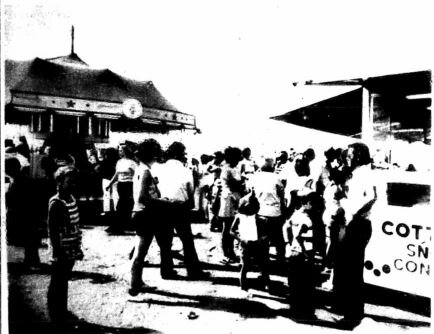Rip Van Winkle
In 1987, the Prior Lake American described St Lawrence Township as “Rip Van Winkle”. While the Village of St Lawrence had floundered due to transportation concerns, the construction of Highway 169 during the 1950s brought new people and businesses to the quiet farm-focused area. Soon several restaurants sprang up along the highway, as well as some attractions. One of the early attractions, Jim’s Apple Farm, now dominates the highway as Minnesota’s Largest Candy Store. Along with these new businesses and attractions, the population of the township began to increase.
Another prominent feature in the area is the Minnesota Valley State Recreation Area. The scenic and recreational potential of the area was recognized early on, and the first park was suggested in 1939. In 1967, a bill proposing an 18,000-acre state park along the river in St Lawrence went before the Minnesota Legislature, but it failed to pass. However a bill creating the Minnesota Valley State Trail did pass in 1969. The trail was to run from Fort Snelling State Park to the town of Le Sueur and include six waysides totaling over 5,000 acres. In this roundabout way, portions of the valley were added to the state park system. The Minnesota Valley National Wildlife Refuge was authorized in 1976 and additional lands originally desired for the state park received federal protection.
Minnesota Valley State Recreation Area
Today the Minnesota Valley State Trail runs through the recreation area with both paved and natural sections. Trails are also in place for hiking, biking, cross-country skiing, horseback riding, mountain biking, and snowmobiling. The landscape of the park includes wetlands, floodplain forest and blufftop oak savanna. The park also provides a home for raccoons, mink, muskrat, wood duck, beaver, white-tail deer, rabbits, squirrels, or red and grey fox.
The Fair and the Threshers
Sunday afternoon at the 1973 Scott County Fair. Photo from the Belle Plaine Herald, August 2 1973
Scott County has hosted a fair since the early days of European American residents. The first fair was held in 1857 with the goal of showcasing the agricultural possibilities of the county and encouraging immigrants to move to the area. Until 1885 the fair was held piecemeal, in the buildings and streets of downtown Shakopee. Then land was purchased just outside of Shakopee, allowing the fair to expand and have a permanent home. In 1915, the fair was held in Jordan for the first time.
In the early 1970s, the Scott County Fair Board purchased 80 acres in St Lawrence Township to be the new home of the Scott County Fair. Ground was broken, and the fair was held in its new home for the first time in 1973.
A new cattle barn, horse barn, 4-H building, sanitation facility, and concessions stand were built on site. Four other fair buildings were moved from the old fairgrounds in Jordan. The Fair Board also chartered busses that ran from the fairgrounds to neighboring communities for a cost of forty cents per passenger.
The big events that year were the horse show, horse pulling contest, 4H auction, demolition derby, tractor pull and chuck wagon races.
St Lawrence Township is also home to the Scott Carver Threshers and the grounds of their annual Harvest Festival. The first threshing festival held by the group was in 1964, after Ernie Morrell suggested to his nephew Ken Scott that they fire up their grandfather’s engine, hook it to the separator, and see if they could thresh some grain.
Today, the mission of the group is “to preserve the agricultural and industrial history from the past for the enjoyment and education of the future generations.” Their annual festival includes displays and demonstrations of steam tractors, engines, threshing, milling, printing, blacksmithing and rug making.
Gravestones and Ghost Stories
St Lawrence has a few unusual gravesites. A single headstone is located in Lawrence Wayside, part the Minnesota Valley State Recreation Area. Before becoming park land, the property was part of the Henry Barlage Farm. The grave is for Frances N Strait who died at age 19 on Dec 21 1860. She was the first wife of George Strait, of milling fame, and the two married when she was only 16. It is unknown why she was buried at a remote, isolated location.
There are also two gravesites on the property of railroad magnate turned farmer Frank Erikson. They are from children who died during the diphtheria epidemic that tore through the county in the 1870s. Clara Frank recalls spending time on the property with her friends in the early 1900s: “I remember when we were children we used to run and play there, but we were always careful not to step on the graves. You never knew what would happen if you stepped on the graves.”
In 2007 a ghost hunter named Kathy visited the Strait house along with a reporter from the Jordan Independent. Kathy asked some questions to any spirits that might be present, including “Are you angry that your house is now a museum”. She thought that she heard a negative response, but the reporter with her didn’t hear anything. She did leave some tape recorders running at the site, and claimed later to have picked up some “evp” or electronic voice phenomena. To ghost hunters, EVP are otherwise inaudible communications from spirits that can be picked up with a tape recorder. The messages were “Repent!”, and the names “Elizabeth” and “Andy Taylor”.
St Lawrence Township Today
Today St Lawrence Township covers 14.9 square miles and has a population approximately 550 people. The township’s board meetings are typically held on the second Thursday of the month at 7 p.m. at the St. Lawrence Town Hall, 7500 Old Highway 169 Boulevard. While the area is still home to farmland, it also has become a place for homeowners who want to live in a rural area and don’t mind having a commute to neighboring towns or the Twin Cities.







